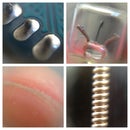Introduction: Paper Mache Skeletons
Halloween just wouldn't be complete without a few skeletons laying around. The problem is, there simply isn't a perfect solution commercially available. The Big Lots skelies (known by home haunters as Bluckies) are cheap, but they look like a bulbous mess. Then there's the defective medical teaching skeletons, but those will cost you an arm and a leg. So, I set out to make a cheap skeleton that was way more realistic than blucky, and settled on paper mache. My method is a little time consuming, but the results are well worth it.
Step 1: Materials
This is what you need to begin-- about 50 or so sheets of newspaper.
You'll also need some duct tape, scotch tape, paper mache glue (I use a flour and water mixture. It's cheap and strong, but won't be weatherproof until you seal it), and paint (I used a can of light brown spray paint for the base, and some dark brown acrylic for details).
Step 2: Making Bones
Roll up 2-3 layers of newspaper corner to corner for a bone. The tighter the better. Use a piece of scotch tape to secure them. You'll need about 22 rolls for a full skeleton.
Fold the arm tubes and leg tubes in half. Then, using your own limbs as reference, fold over the extra paper on the thin side and tape it down.
Step 3: More Bones
The ribcage is a little trickier. If you search around for some reference shots, you'll see that a real ribcage has a rather egg-like shape from the front (also note that I didn't get it quite right on this one). Out ribs are loops of those newspaper tubes we made earlier (use your own chest to approximate the size). Make somewhere around 6-10 of them.
Tape the ribs to another tube that will act as the spine (in some of my more recent skeletons, I have used a piece of 3/4" pvc pipe for a spine, as it is much stronger and can even be bent into a slight "S" shape with a heat gun (as a real spine would appear). However you form it, beef up the base of the spine with some more tubes. How long should you make it? Use yourself as reference.
Those circular squiggley things are for the pelvis. There are more accurate ways to form it, however, since most people won't know the difference, this will suffice.
Step 4: Knobbly Bits
Crumple up some 1/2 sheets of newspaper for the knobbly bits on the ends of the bones and tape them on tightly.
Then, cut a piece of cardboard for that thing in the middle of the ribs. Tape it to all of the ribs, front and back. If you want, you can also fashion some triangular-shaped shoulder blades from cardboard.
Step 5: Paper Mache
Tear up a ton of newspaper into strips and dip them in your paper mache glue. Once again, I use a mixture of flour and water (there's no exact ratio that I'm aware of, just mix it so that it's a little on the thick side). Give the whole thing a coat or two and set it outside to dry.
Step 6: Painting
Give that guy a good coat of your base color. The newsprint tends to soak in a lot of the paint, so I suggest buying two cans of the spray.
With some dark brown acrylic, sponge on the texture all over. You can cheat, if you know at what angle people will be viewing the final prop.
At this point, you're probably wondering what we're going to do about the skull. My advice: just buy one of those four dollar foam skulls and hot glue it on. It's just not worth your time to try to make a realistic skull from scratch. Of course, you can always embellish it.
You'll also want some way to keep those bones together. I drill a small hole into the end of each one and glue a piece of wire in, connecting the two bones together.
Step 7: Some Finished Products
Here's one I've prepared earlier...
Participated in the
DIY Halloween Contest













